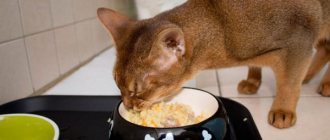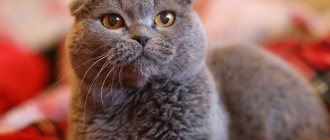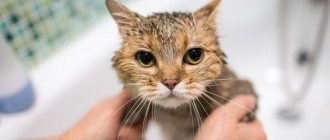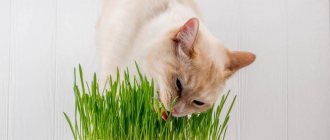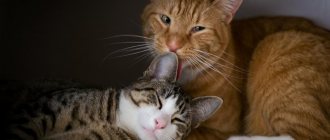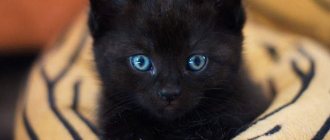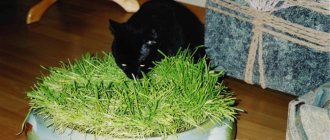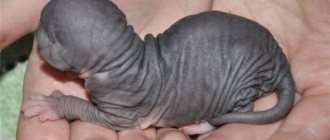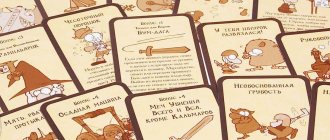Even if you've never had a cat, you might have seen street cats sitting on the lawn in the summer and happily eating green grass. Or you could see the consequences of how your pets quietly nibbled your favorite indoor plants.
Not all indoor plants are beneficial for cats; many can cause harm to the pet. It is worth protecting indoor plants from cat attacks. To avoid negative consequences, let's look at a few important questions: what grass do cats eat, favorite grass for cats, how to grow grass at home.
Why do cats eat grass?
The need for grass in a cat’s diet is determined by the physiological specifics of its body, as well as by many reasons that prompted its interest in such diversity.
Main reasons:
- The grass chosen for the cat helps replenish the animal's diet. It contains various vitamins and folic acid. These elements are necessary for the normal functioning of the cat’s vital systems. Her body is not able to independently produce certain types of microelements, and the cat compensates for the deficiency of these elements and vitamins by eating grass. The content of the herb affects the increase in the amount of oxygen in the blood. If the cat is pregnant, the plant helps to bear healthy offspring.
- The constant intake of dry food or other food creates a need for the animal to cleanse the body. The herb has a laxative effect, helping to cleanse the body of excess accumulations.
- All cats are clean; they constantly clean their fur by licking themselves. Each time she licks, she swallows fur. Over time, hair from the fur accumulates in a significant amount in the form of a lump in the pet’s stomach. When a cat eats grass, it induces vomiting and thus clears its stomach of hairballs.
- Cats are very smart creatures. Some of them need weed as a laxative, and some as a fixative. If an animal needs grass for strengthening, it chooses greens with narrow stems, and in case of need for a laxative effect, with wide shoots.
- Cats also choose grass based on its taste. Sometimes they bite the grass and don't swallow it. This is how they enjoy the juice of the plant.
Reasons for temporary vegetarianism
All cats need grass: wild, outdoor, domestic. Becoming a vegetarian for a while is instinctive and natural.
It is not known exactly why cats eat grass, but there are several versions:
- the herb is a natural means of cleansing and stimulating the intestines, fighting parasites;
- the grass curls up into lumps along with the hair and is excreted by regurgitation or through the intestines;
- greens contain minerals, B vitamins, folic acid, which are not found in meat; cats know instinctively which greens are needed at a particular moment;
- some herbs contain substances that act as pain relievers on animals;
- sometimes cats just like the taste of greens.
You should not prohibit your domestic cat from eating grass while walking. It is necessary because it helps improve health and prolong life. There is an opinion that greens help against obesity if the cat is sterilized (neutered).
The situation is different with indoor flowers. Cats are not always able to determine which ones are likely to cause harm. Therefore, before planting new flowers on the windowsills, it is advisable to find out whether the cat can be poisoned by their leaves. If there are such indoor plants (dracaena, ficus, ivy, begonia), it is important to exclude the possibility of access.
At what age can it be given?
According to veterinarians' recommendations, a cat can start eating grass from 4 months of age. You need to gradually add a special herb purchased from a pet store to your baby’s diet. You can also purchase plant seeds in specialized stores. The body must gradually get used to the new food. Cats do not eat all plants; they prefer cereal grasses, such as sedge.
In pet stores you can purchase special dry food that helps remove hairballs, intended for ages from 1 to 10 years. You can also buy malt - a paste to add to the food of a pet that eats wet food and natural food. This paste should be used with caution, according to the instructions, in order to avoid the formation of intestinal blockages from hairballs.
What plants can cause the death of an animal?
Dangerous and even deadly plants that kitties are prohibited from eating include:
- geranium;
- calendula;
- aloe;
- Melissa;
- peppermint;
- lily.
In fact, the list of dangerous plants is very long. Therefore, before buying a new indoor plant, you need to make sure that it will not be dangerous for the cat. Of course, a kitty is unlikely to eat a toxic plant. But this risk cannot be excluded either.
What grass should I plant?
Cats are amazing creatures. They are very fond of certain types of herbs; this is inherent in them at the genetic level. Fluffy caprices like their taste and smell, they feel what herbs the body needs for normal functioning. Indoor-grown grass from oat, wheat, and barley seeds is quite juicy and pleasant for your pet. You can grow them without much difficulty.
According to experts, there are certain plants that are suitable for cats. It is their planting that is recommended at home.
- Oats and wheat. Such herbs are very popular with cats; their seeds are most often sold in bags in pet stores. Cereal sprouts with a height of no more than 30 cm are more beneficial for pets, since elements that are toxic to the animal can accumulate in tall stems.
- Lemongrass. Cats love her. Grows up to a meter. This herb has many advantages over other plants. It has a diuretic and antiseptic effect, calms the nervous system.
- Cat mint. Requires more sun for normal growth. Has a powerful natural antibiotic effect. Plant phytohormones act as a stimulus for happiness on cats.
- Peppermint, lemon balm. Pets can eat it continuously, so you need to monitor your cat so that it does not develop an upset stomach.
- Parsley. Rich in vitamins (A, B, C) and potassium, the plant is a real storehouse of useful elements for cats.
- Marigolds and violets. The cat will not pass by these flowers indifferently.
- Valerian. Highly appreciated by furry gourmands. It is quite difficult to grow a plant in a pot.
- Lavender. Can be grown from seeds, has a sedative effect.
All of these plants can be grown on your windowsill so that your cat can enjoy the grass and be healthy.
Pet stores also sell special herbs for cats, which have recently found popularity among cat owners.
The most popular are:
- Titbit Cat Grass;
- Grass for cats Skakun Gavrish.
Titbit
A natural product, no artificial substrates are used for its cultivation.
The technological drainage bag provides drainage with a greenhouse effect, which promotes good seed growth.
The grown plant is rich in vitamins and folic acid, activates the pet’s digestion, and cleanses the cat’s stomach of accumulated hairballs.
It is very convenient to use, since after the seeds have outgrown in the tray, there is no need to make drainage holes and rebuild the tray.
Recommended for use on cats of all ages. Package weight - 40 grams; can be stored for a year after production.
Titbit grass review
Opening the package is very convenient, the tray is durable. The grass appears in 8 days. Does not include chemical elements. The synthetic bag helps prevent the grains from falling out. On the back of the label you can see growing instructions. Caring for the plant is easy. You need to water 30 ml every 5 days. A very convenient and useful option.
Grass for cats Skakun Gavrish
For planting, you can use a pot or box designed for growing fresh grass.
The contents of the package must be sown in a randomly selected substrate and watered generously. After 3 days the first grass appears, after 15 days the grass height reaches 10 cm.
When the height of the grass reaches up to 10 cm, you can allow the cat to feast on the plant. You can grow fresh grass from seeds all year round. The cost is not high, about 12 rubles.
Review of the herb Skakun Gavrish
After planting and abundant watering, the grass sprouted already on the 3rd day. Only 1/3 of the bag was used; I used good soil for planting.
High-quality seeds, with neat packaging and good composition. The cat really loved the plant.
How to grow cat grass at home
Growing grass for your cat yourself will be the best solution, since it guarantees environmental safety and gives the animal year-round access to juicy and fresh greens. Grass planted in beautiful containers can successfully diversify the interior of the apartment.
You can find a witty design solution for placing grass for a cat
Seed selection
For the first time, in order to determine the cat’s taste preferences and give her a choice, it is better to sow several types of plants. Seeds need to be purchased from trustworthy places - specialized stores; a box of oats can be bought at a pharmacy. You should not buy seeds in bulk at the market or from unknown persons on the Internet; they may be poisoned and unsafe for the cat’s health.
How to plant grass
You can grow grass for your furry pet as follows:
- It is necessary to choose a container for planting grass; it must be wide and stable, have holes at the bottom for drainage of water after watering, as well as a tray. Some cat owners use a new cat litter box for these purposes that the pet has not used (otherwise the cat will continue to use it for its intended purpose).
- Choose a substrate, it can be a ready-made soil mixture, or you can make it yourself if you wish.
- Planting seeds and subsequent care of seedlings is carried out approximately as follows: Part of the well-moistened substrate is evenly distributed along the bottom of the container, then the seeds are laid in a continuous layer and covered with a second, thinner layer of soil mixture soaked in water. It is necessary to ensure that after planting, the substrate and seeds occupy only half the volume of the container, since, as the seeds germinate, they lift the soil mixture.
- Then the container is covered with cling film to create a greenhouse effect, facilitating seed germination. Light is not needed at the germination stage, but warmth is desirable. Shoots appear approximately on the 2-3rd day.
- When the first shoots appear, the container with the grass should be placed in a bright place; when the crops grow to 1–2 cm, the film can be removed; on the 6th–7th day you can already offer treats to the cat. The container should be placed so that there is enough light for the grass and the pet has free access to it.
Grass can be placed in a resting place for cats
In order for the cat to have grass all the time, conveyor sowing is used, using 3-4 containers, sowing the next container during the seed germination phase of the previous one.
Grass grasses should not be allowed to overgrow, since when the shoots reach a height of 25 cm, they begin to accumulate substances that are toxic to cats.
Video: how to grow grass for a cat
How to grow grass without soil
In some cases, the cat prefers to uproot and scatter the grass, as well as dig out the substrate in the container with its paws, throwing out the soil. To reduce the mess, it is possible to grow grass without using soil. In this case, substrate substitutes can be:
- cat litter;
- sawdust;
- substrate components - perlite, vermiculite;
- several layers of moistened gauze, as well as moistened wipes, cotton wool, toilet paper.
To grow grass between layers of gauze, napkins, and paper, proceed as follows:
- Make holes for liquid drainage in the bottom of a disposable plastic plate.
- Seeds soaked in water for an hour are placed in it and covered with the selected material (gauze, napkins, cotton wool), moistened and distributed in several layers; The crops are removed to a warm place.
- With the appearance of the roots, usually on the 2-3rd day, the sprouted seeds are laid on the surface of several moistened layers of the selected material and the plate is covered with cling film.
- When the sprouts appear, the film is removed and the seedlings are provided with good lighting.
The disadvantage of this method is that in the absence of moisture the grass dries out very quickly, and with excess moisture the roots begin to rot. Within a week, the grass withers, not receiving nutrition from the substrate.
The use of vermiculite seems optimal. This is a compromise option: vermiculite is a natural porous mineral, it is absolutely environmentally friendly. When scattered from a container by a cat, this mineral pollutes surfaces much less than regular soil. Vermiculite has a high moisture capacity and releases water to plant roots as required, which makes seedlings less dependent on timely watering. The mineral contains trace elements necessary for plants: iron, manganese, magnesium and others. Vermiculite can and should be reused. The best vermiculite is mined in the Ural mountains; it is light with a slight yellowness; the results of its use are comparable to the results of growing plants in expensive soil mixtures with the regular use of growth activators. Before use, vermiculite should be soaked in water for an hour.
Another opportunity to grow grass and keep your apartment clean is to use a grass garden - Catit Senses 2.0 Grass Planter. Its cost is 1292 rubles. This is a ready-made product with a pleasant design; its design prevents the soil mixture from turning over and scattering. The device is also equipped with an addition: its rubber mat also serves for acupuncture massage of the cat’s paws.
The device prevents soil from being scattered and the container from turning over
How to Plant Cat Grass with Soil
To plant grass using this method, you need to take seeds from a pet store or just a handful of wheat or other grain. You can use black soil or store-bought soil as soil. You will also need a pot and a plastic bag.
The soil is poured into a vessel for germination, leaving space on top for seeds and a loose layer of soil. The seeds are pre-soaked in water for an hour, then poured onto the ground. Sprinkle earth on top (about 3 cm). At the end, water the grass and cover the vessel tightly with plastic wrap to speed up germination.
Rules for successfully growing weed for cats
Each growing kit comes with instructions to help you grow lush greens for your pet.
However, there are general rules that will help you avoid mistakes:
- Water the seeds daily, but the soil or substrate should not be too wet. The preferred watering option is spraying with a spray bottle.
- The best place for the container is a windowsill (in warmer months) or a table in a well-lit room. In winter, you should not send a jar of grass to the window, as the tender sprouts may freeze. If you place the tray next to the radiator, this will quickly dry out the substrate or other filler, and the grass will not sprout.
- You cannot cover the seeds with a thick layer of soil; the optimal thickness is 0.5-1 cm.
- A lack of light will cause the greenery to become stunted.
- You can speed up the growing process. To do this, the seeds are soaked in warm water for a couple of hours and then planted in the prepared substrate.
Grass from a container is an excellent replacement for outdoor greenery. It is not contaminated with parasite eggs and is not polluted by exhaust gases from cars. This grass will bring a lot of benefits to your pet, especially in winter.
Planting grass for cats without soil
The method is quite simple. Take 2 plastic plates and make holes in one of them so that unnecessary amounts of water can escape. The plate with holes is placed in a whole plate, at the bottom of which there is a layer of soaked cotton wool. Grain is scattered on it and covered with gauze. Water again and place the plates in the bag. After germination, the bag is removed. The method is more convenient in that when eating grass, the cat can scatter the soil, tearing out the plant with its roots.
For planting, it is best to use a flat and wide vessel, or a tray. Instead of soil, toilet filler is used here. The granules are poured into a tray in a layer of 3 cm and filled with water. After some time, a mass resembling gruel forms in the tray.
By moving the top layer, seeds are poured and covered with a layer of filler. The tray and filler must be clean.
What grass should you not give to your cat?
Most cats can distinguish beneficial herbs from harmful types. When free-ranging, they can eat outdoor grass if they like it. However, this is not safe for the animal. In this way, he may be at risk of contracting worms or other infections through dust or worm eggs found on the grass.
Cats avoid:
- Sagebrush;
- Datura;
- Hogweed;
- Belen;
- Buttercup;
- Poppy.
Most of them love to eat chamomile or wheatgrass.
At home, you should be wary of using mint, valerian or other plants with intoxicating effects. Such herbs in large doses can cause gastrointestinal disorders in cats.
Cat mint
It has long been noticed that cats are partial to a variety of mint, which was nicknamed lemon catnip (or mint). Cats really love to chew and smell this plant, because it has a strange effect on them: some pets calm down, others, on the contrary, become active.
Catnip is added to many pet toys to make them attractive to cats.
Attention! With the help of this plant you can accustom your pet to his house. All you have to do is put dried grass inside, and your cat will be happy to be there.
Reasons why a cat doesn't want to eat grass or eats too much
Not all cats are grass lovers, even if it is intended specifically for them. Cat owners, as well as veterinarians, believe that if a pet refuses to eat grass, then it does not need it. Cats are quite smart creatures; you should not force feed them grass, adding it to their food, or use various special pastes. If the animal’s body does not require such food, there is no need to overload the cat’s stomach, unknowingly causing harm to the pet.
If your cat starts eating too much grass, you should see a doctor because this could be a sign of digestive problems.
How to stop a cat from eating houseplants
First of all, the pet must be provided with a replacement for home flowers - fresh grass grown especially for it, since eating green vegetation is common to all cats.
The simplest method is to separate the cat and the flowers. The latter can be placed in a place inaccessible to the animal, if one is found; The best solution would be to grow flowers in a separate room, closed from the cat.
Cats cannot stand the smell of citrus fruits and spices - you can mix aromatic oils of orange, neroli, lemon in a spray bottle and spray the leaves of plants and soil in pots. Perhaps dry citrus peels placed in flower pots will help. You can also spray the soil in the pot with a special hot pepper spray.
You can buy a special product at the veterinary store - Antigryzin.
If the cat uses a flower pot as an additional tray, it is better to sprinkle shells on the surface of the soil. Their unevenness and rustling will cause discomfort to the cat, but at the same time they do not interfere with the access of oxygen to the roots of the plant.
